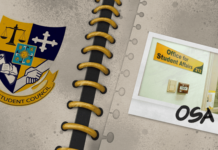THE STUDENT publication scene in UST is perceived as one of the liveliest in the country. Nearly every faculty and college has a student organ, something that could not be said of other universities that hardly have a student press, much less a student publication index to boast of. However, red tape, indifference or non-cooperation of college or faculty administration, ignorance among campus writers and college administration of the Campus Journalism Act, and even editorial meddling by the college officialdom conspire to make the campus press in UST less than lively.
“Less than lively” is not good for the students. The UST administration collects a student journal fee from nearly every college or faculty. The rate varies – from as low as P10 per student in the College of Nursing to as high as P750 in the Faculty of Medicine and Surgery. If the student editorial staff fails to come out with issues because of administrative obstacles, then the students don’t get their money’s worth. Their money is wasted.
Perhaps even worse, students are deprived of channels of expression. Although administrators may pigeonhole student organs as agencies of student dissent—and irresponsible dissent at that –the publications play other important roles, such as opportunities to test the students’ communicative abilities, as agencies for student creativity, as openings for research abilities, and as means to popularize researches and studies.
The problem appears to boil down to ignorance by students and administrators of Republic Act 7079, the Campus Journalism Law. The law gives student writers press autonomy and the authority to dispose of student publication funds, with the administration merely acting as a custodian to the money. But certain college or faculty administrations have chosen to intervene editorially and even block or veto budgetary requests of student editors.
At the Faculty of Arts and Letters, the Flame, according to its editor in chief, Angelo Suarez, suffers from the slow release of funds. He added that the administration has not provided the staff a financial report to enable the editorial board to plan its budget.
Suarez said the dean’s office always tells the Flame that the journal is not part of the faculty’s budget. “But we all know that the money shouldn’t be from the faculty budget because it should come from the journal fee,” he explained.
Dean Belen Tangco said her office has acted on the fund requests. She explained that current staff was even able to release the issues that the previous editorial boards had failed to produce.
Although the Flame has its own office, it does not have computers. The staff said that in the last accreditation of the Faculty, the administration repainted the office, replaced the old and rickety chairs, and installed three new computers, which however were pulled out when the accrediting team left.
Tangco said the computers had been merely borrowed from the dean’s office and so were returned eventually. She said her office tries its best to support the publication.
This year, Tangco is seeking to restructure the Faculty’s publication so that it could accept contributions from students from all the majors. Suarez said he shares the Dean’s concerns and hopes to foster better working relations with her.
The Faculty of Pharmacy’s Purple Gazette also failed to release its journal for the first semester of school year 2002-2003 due to the slow release of its publication fund.
But Pharmacy Dean Rosalinda Solevilla said her office had only been too ready to release the funds of the paper.
She expressed disappointment at the failure of the staff to come up with a technical journal in time for the accreditation of the Faculty. She said the Gazette had only published a literary journal.
But previous staffers said they had been given the runaround when they made requisitions.
They said they had to rent computers to encode articles and they were not reimbursed when they submitted the receipts.
Sollevilla said the Purple Gazette did not make any request for reimbursements. She explained the paper could use the computers in the laboratory, but admitted other students could also avail of them. She said she had approved the organ’s request for a new office, but it is still incomplete.
The staff had also asked for stipend and honorarium. Solevilla explained that since the issue is sensitive, she referred the matter to the adviser for study.
The College of Fine Arts and Design did not have any journal last year because it used the journal funds to buy a Mackintosh computer, Diane Taar, College Fine Arts and Design student council president, said.
According to Nolan Fabular, council P.R.O., one of the council’s projects is to publish a folio this year. He said he would lead the organization of the publication staff.
R. A. 7079 says that a student publication should be run and managed by a duly established editorial board and staff, not the student government.
Meanwhile, the College of Science Journal said it had barely operated last year for lack of funds despite the fact that the college collects a P100 student journal fee from the 2,000 students—around P200,000 per semester. But in some instances, staffers had to use their own money for the publication.
Dorcas Crooc, the editor in chief, said the printing cost was around P60,000 per semester. She said the publication needed the operational funds to buy equipment to do its work, such as a scanner and a camera.
But the administration turned down requisitions and the staff was forced to use personal money to rent equipment, according to Angeli Santa Maria, last year’s editor in chief. They submitted the receipts to the administration, but they have not been reimbursed.
Santa Maria said two years ago an editor brought her scanner and laptop to finish an issue. The staff’s only camera got lost in a robbery in the Main Building and has yet to be replaced. They have two computers, but right now only one is working. Whenever they would ask the dean’s office to have it repaired, the office would recommend the college technician who was often too busy to attend to their concerns.
The staff also requested for honoraria, but although the office of the dean approved it, the Treasurer’s Office has not yet released the money, Santa Maria said.
According to Science Dean Fortunato Sevilla, the problem with the previous editorial board of Science Journal was that they did not canvass before they proposed to purchase an item. He recalled that a few years back, students replaced the parts of a working computer with defective ones.
Even if a requisition is granted, some kinks occur. Thomasian Engineer (TE) editor in chief Aileen Grace Soliven said they once had to repeat the whole paper chase because they were given a “substandard” computer.
“Pagdating sa lay-outing bigla na lang siyang magba-bog down, so sira na lahat. Start kami ulit,” said Soliven.
Soliven also complained they are not furnished a financial report to properly budget their operations. At one time, they had to repeat the paper’s layout because they discovered they did not have enough funds to print the issue in two colors, she said..
In some instances, the administration meddles editorially in the paper. The College of Architecture’s Vision failed to publish its first edition during school year 2002-2003 because the administration wanted to join in the editing.
According to Vision adviser Prof. Manuel Maximo Noche, the staff had done its work, but the problem was with the editing of the final copy.
“We have already submitted the dummy, but the dean is insisting that there is still a need for the magazine to be re-edited with him present,” said Noche.
He added that the issue was released only last year because the draft “slept in the office of the dean for almost four months before it was finally published.” The issue supposedly due last year also remains unpublished.
Architecture Dean Augusto Concio said he was just waiting for the editors to come to his office as he wanted to edit the paper with them, but they did not show up. He said that there was a need to edit the paper because Architecture students do not have formal training in writing.
Noche advised that “the office of the dean should assign whoever needs to be assigned, if the articles need further editing” to avoid delays.
Current editor Bonnie Niña Borga said she often visited the Concio’s office last year, but she was not aware that Concio wanted to edit the contents with them.
For their college journal, Nursing students pay P10, the lowest among journal fees. But the issue comes out regularly.
Rodolfo Veloso, the editor in chief, said the journal does not have big problems. “Our regent tells us that the student pays only P10 per semester but sometimes we come up with issues worth P14 each copy. But he tells us that there is a reserved budget for that,” he said.
“Di sinsasabi ni Father (Regent Fr. Antonio Cabezon, O.P.) kung saan nangagaling ‘yung pera. But whenever we need money for the publication, he releases funds.”
The Commerce Journal has no problems either. Although budget requests take time, the delays are manageable, said Chinensy de los Santos, the editor in chief.
The Conservatory of Music’s EMIC Journal does not suffer from budget woes, according to Allan Pastrana, the editor.
“Mabilis naman dito, actually, may balak din kaming mag-cut ng costs e. Feeling nga namin nag-aabono sila (dean’s office),” said Pastrana.
The Faculty of Medicine and Surgery students pay P750 per semester for their journal, the highest among the journal fees in the University.
Faculty Secretary Jose Blas said the fee funds the Faculty’s quarterly News Gazette and the Medicine Journal, where the research works of doctors and students are published. The journal fee funds the forwarding expenses of these articles.
Student Council president Marc Gellynck said the journal of the Faculty reflects the high quality of education there.
Meanwhile the College Rehabilitation Sciences’ journal, Therapeutic Currents, does not have major problems as it was able to publish three or four issues a year, depending on the performance of its staff, said student council president Eugene Lao.
After 10 years, the Faculty of Civil Law revived its journal last March.
Atty. Rene B. Gorospe, adviser of the UST Law Review, said the long absence was due to the reluctance of students to join the publication because of the rigors of academics.
But Dean Augusto Aligada, Jr. pressed for the revival of the Law Review. Although some students complained when the selection committee chose dean’s listers as staff members, Gorospe explained that it was best to check first how those chosen would fare. He said the point was to revive the publication at once.


















